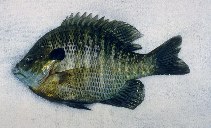Lepomis macrochirus Rafinesque, 1819
Bluegill
Hochladen Photos und videos
Pictures | Videos | Google BildLepomis macrochirus
Male picture by Lovshin, L.
Pictures | Videos | Google BildLepomis macrochirus
Male picture by Lovshin, L.
Mexico country information
Common names:
Mojarra oreja azul
Occurrence: native
Salinity: freshwater
Abundance: | Ref:
Importance: highly commercial | Ref: Lyons, J., G. González-Hernandéz, E. Soto-Galera and M. Guzmán-Arroyo, 1998
Aquaculture: | Ref:
Regulations: | Ref:
Uses: no uses
Comments:
National Checklist:
Country Information: https://www.cia.gov/library/publications/resources/the-world-factbook/geos/mx.html
National Fisheries Authority:
Occurrences: Occurrences Point map
Main Ref: Contreras-Balderas, S. and M.A. Escalante-C., 1984
National Database:
Occurrence: native
Salinity: freshwater
Abundance: | Ref:
Importance: highly commercial | Ref: Lyons, J., G. González-Hernandéz, E. Soto-Galera and M. Guzmán-Arroyo, 1998
Aquaculture: | Ref:
Regulations: | Ref:
Uses: no uses
Comments:
National Checklist:
Country Information: https://www.cia.gov/library/publications/resources/the-world-factbook/geos/mx.html
National Fisheries Authority:
Occurrences: Occurrences Point map
Main Ref: Contreras-Balderas, S. and M.A. Escalante-C., 1984
National Database:
Common names from other countries
Klassifizierung / Names Namen | Synonyme | Catalog of Fishes(Gattung, Arten) | ITIS | CoL | WoRMS | Cloffa
> Centrarchiformes (Basses) > Centrarchidae (Sunfishes)
Etymology: Lepomis: Greek, lepis = scaled + Greek, poma = gill cover, operculum (Ref. 45335, 79012); macrochirus: macrochirus meaning large hand, probably referring to the body shape (Ref. 10294).
More on author: Rafinesque.
Etymology: Lepomis: Greek, lepis = scaled + Greek, poma = gill cover, operculum (Ref. 45335, 79012); macrochirus: macrochirus meaning large hand, probably referring to the body shape (Ref. 10294).
More on author: Rafinesque.
Environment: milieu / climate zone / depth range / distribution range Ökologie
; süßwasser benthopelagisch; pH range: 7.0 - 7.5; dH range: 10 - 15. Subtropical; 1°C - 36°C (Ref. 35682); 50°N - 25°N
Verbreitung Länder | FAO Gebiete | Ecosystems | Vorkommen | Point map | Einführungen | Faunafri
North America: St. Lawrence - Great Lakes and Mississippi river basin; from Quebec to northern Mexico. Widely introduced. Several countries report adverse ecological impact after introduction.
Size / Gewicht / Alter
Maturity: Lm ? range ? - ? cm
Max length : 41.0 cm TL Männchen/unbestimmt; (Ref. 5723); common length : 19.1 cm TL Männchen/unbestimmt; (Ref. 12193); max. veröff. Gewicht: 2.2 kg (Ref. 4699); max. veröff. Alter: 10 Jahre (Ref. 72462)
Max length : 41.0 cm TL Männchen/unbestimmt; (Ref. 5723); common length : 19.1 cm TL Männchen/unbestimmt; (Ref. 12193); max. veröff. Gewicht: 2.2 kg (Ref. 4699); max. veröff. Alter: 10 Jahre (Ref. 72462)
Kurzbeschreibung Bestimmungsschlüssel | Morphologie | Morphometrie
A dark blue or black "ear" on an extension of the gill cover called the opercular flap; a prominent dark blotch at the base of the dorsal fin, close to the tail; typically olive-green backs, with a blue or purplish sheen along the sides; faint vertical bars may be present along the sides; breeding males may have more blue and orange coloration on their flanks (Ref. 44091).
Adults are found frequently in lakes, ponds, reservoirs and sluggish streams (Ref. 5723, 10294); occur primarily in reservoirs in Hawaii; preferably live in deep weed beds (Ref. 5723). Active mainly during dusk and dawn. They feed upon snails, small crayfish, insects, worms and small minnows (Ref. 5723). Young feed on crustaceans, insects and worms (Ref. 5723, 10294).
Life cycle and mating behavior Geschlechtsreife | Fortpflanzung | Ablaichen | Eier | Fecundity | Larven
Males guard the eggs for about 7 days (Ref. 93240).
Hauptreferenz
Upload your references | Referenzen | Koordinator | Partner
Page, L.M. and B.M. Burr, 1991. A field guide to freshwater fishes of North America north of Mexico. Houghton Mifflin Company, Boston. 432 p. (Ref. 5723)
IUCN Rote Liste Status (Ref. 130435: Version 2024-2)
nicht bedroht (LC) ; Date assessed: 21 August 2018
Bedrohung für Menschen
Potential pest
Nutzung durch Menschen
Fischereien: weniger kommerziell; Aquakultur: kommerziell; Sportfisch: ja; Aquarium: Kommerziell
FAO(Aquaculture systems: production; ; publication : search) | FishSource |
Mehr Information
Population dynamics
Growth parameters
Max. ages / sizes
Length-weight rel.
Length-length rel.
Längenhäufigkeiten
Mass conversion
Rekrutierung
Dichte
Growth parameters
Max. ages / sizes
Length-weight rel.
Length-length rel.
Längenhäufigkeiten
Mass conversion
Rekrutierung
Dichte
Life cycle
Fortpflanzung
Geschlechtsreife
Fecundity
Ablaichen
Spawning aggregations
Eier
Eientwicklung
Larven
Larven Pop.Dyn.
Fortpflanzung
Geschlechtsreife
Fecundity
Ablaichen
Spawning aggregations
Eier
Eientwicklung
Larven
Larven Pop.Dyn.
Anatomy
Kiemenoberfläche
Brain
Otolith
Kiemenoberfläche
Brain
Otolith
Physiology
Body composition
Nutrients
Oxygen consumption
Swimming type
Swimming speed
Visual pigments
Fish sound
Diseases & Parasites
Toxicity (LC50s)
Body composition
Nutrients
Oxygen consumption
Swimming type
Swimming speed
Visual pigments
Fish sound
Diseases & Parasites
Toxicity (LC50s)
Human related
Aquaculture systems
Aquakultur Profile
Zuchtlinien
Ciguatera cases
Stamps, coins, misc.
Aquaculture systems
Aquakultur Profile
Zuchtlinien
Ciguatera cases
Stamps, coins, misc.
Tools
Bio-Quiz | E-book | Feldführer | Bestimmungsschlüssel | Längenhäufigkeits Tool | Lebensdaten Tool | Punkt Karte | Classification Tree
| Catch-MSY |
Zusatzinformationen
Download XML
Zusammenfassung | Point data | Namen | Photos
Internet Quellen
Alien/Invasive Species database | Aquatic Commons | BHL | Cloffa | BOLDSystems | Websites from users | FishWatcher Einträge suchen | CISTI | Catalog of Fishes(Gattung, Arten) | DiscoverLife | ECOTOX | Faunafri | Fishtrace | GenBank(Genom, nucleotide) | GloBI | GOBASE | GoMexSI (interaction data) | | Google Books | Google Scholar | Google | IGFA World Record | MitoFish | Otolith Atlas of Taiwan Fishes | Öffentliche Aquarien | PubMed | Reef Life Survey | Scirus | SeaLifeBase | Tree of Life | Wikipedia(Gehe zu, Suchen) | World Records Freshwater Fishing | Zoobank | Zoological Record
Estimates based on models
Phylogenetic diversity index (Ref. 82804): PD50 = 0.5001 [Uniqueness, from 0.5 = low to 2.0 = high].
Bayesian length-weight: a=0.01380 (0.01182 - 0.01611), b=3.13 (3.09 - 3.17), in cm Total Length, based on LWR estimates for this species (Ref. 93245).
Trophic level (Ref. 69278): 3.2 ±0.2 se; based on diet studies.
Widerstandsfähigkeit (Ref. 120179): mittel, Verdopplung der Population dauert 1,4 - 4,4 Jahre. (K=0.19-0.23; tmax=11).
Fishing Vulnerability (Ref. 59153): Low to moderate vulnerability (33 of 100).




